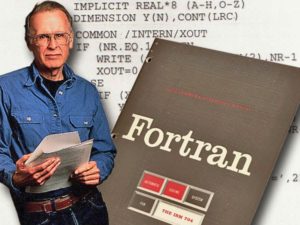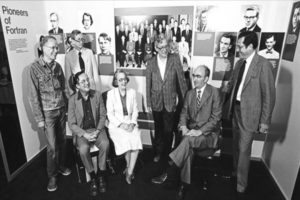The FORTRAN Programming Language

Jhon W. Backus, driving force behind FORTRAN’s development
Developed by IBM in 1950 to reduce the effort of implementing solutions to scientific and engineering tasks (until that date developed in assembly language). The development of FORTRAN was parallel to that of the compilers, it was the first language that had a compiler and that allowed to port programs to different machines. In addition, many changes and evolution of the compilers were motivated by the need for FORTRAN to generate efficient code.
First of the “modern” programming languages, its syntax has aged badly (as early as 1968, an article signed by the creators of BASIC described it as “old-fashioned”). However, despite not being viewed by the community as a general-purpose language, FORTRAN is the programming language that has dominated scientific application development for nearly six decades. Even today (2021), it occupies the 20th position in the TIOBE ranking of popularity of programming languages (34th in 2020).

Some of the creators of FORTRAN in 1982. Source: IBM
FORTRAN has been essential in areas of intensive calculation such as: astronomy, computational fluid dynamics, finite element analysis, weather modeling and prediction or satellite simulation. This made the different standardized versions maintain compatibility with the previous ones, while including capabilities from structured programming (in 1977), object orientation (in 2003) or concurrent programming (in 2008).
Currently, the availability of large specialized libraries (usually implemented in C or C ++) means that the scientific community is migrating to new high-level languages such as Python or Matlab. All this led FORTRAN to incorporate conversion facilities to C.
Today, many of the performance evaluation tasks for new supercomputers are written in FORTRAN.
FORTRAN
Born:1957
Evolution: FORTRAN II (1958); FORTRAN IV (1962); FORTRAN 66; FORTRAN 77; Fortran 90; Fortran 95; Fortran 2003; Fortran 2008; Fortran 2018;
Influences of: —
Influences: Algol 58; BASIC; C; PL1
